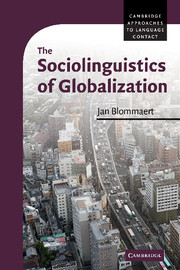Book contents
- Frontmatter
- Contents
- List of illustrations
- Series editor's foreword
- Preface
- Acknowledgements
- 1 A critical sociolinguistics of globalization
- 2 A messy new marketplace
- 3 Locality, the periphery and images of the world
- 4 Repertoires and competence
- 5 Language, globalization and history
- 6 Old and new inequalities
- 7 Reflections
- Notes
- References
- Index
5 - Language, globalization and history
Published online by Cambridge University Press: 05 June 2012
- Frontmatter
- Contents
- List of illustrations
- Series editor's foreword
- Preface
- Acknowledgements
- 1 A critical sociolinguistics of globalization
- 2 A messy new marketplace
- 3 Locality, the periphery and images of the world
- 4 Repertoires and competence
- 5 Language, globalization and history
- 6 Old and new inequalities
- 7 Reflections
- Notes
- References
- Index
Summary
Historical concepts
Understanding globalization is understanding a historical process, something that has considerable depth in time, and something in which we can discern different stages and moments of development. I underscored the importance of this point earlier in this book and now return to it. The difficulty we face was exemplified in Fairclough (2006): we can only observe globalization synchronically, while we can only understand it historically. Consequently, we must develop conceptual tools that are at least historically sensitive, that suggest and open a space of historical analysis and interpretation.
History, of course, is not the same as diachrony. It is not sufficient to specify a time-line along which sociolinguistic features develop and on which certain ‘dots’ mark important moments (a problem in some work on language policy and language planning). History means that time is filled with human activity, with actors who stand in various kinds of relationships to one another and whose actions influence those of others. Power, hierarchy, authority, normativity are central in understanding historical processes: history is filled with power and conflict (cf. Blommaert 1999a). Some works can be used as examples of historical sociolinguistic analysis. Bonfiglio (2002) reviews the genesis of ‘standard American’ accents and sets it against a panorama of race and ethnic relations, twentieth-century xenophobia and the emergence of new elites in the USA. We hear the voices of the ambitious in his study, and we see language ideology being articulated by identifiable actors to other identifiable actors.
- Type
- Chapter
- Information
- The Sociolinguistics of Globalization , pp. 137 - 152Publisher: Cambridge University PressPrint publication year: 2010

